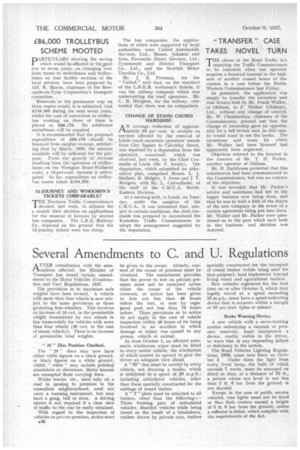Several Amendments to C. and U. Regulations
Page 62

If you've noticed an error in this article please click here to report it so we can fix it.
AFTER consultation with the associations affected, the Minister of Transport has issued 'certain amendments to the Motor Vehicles (Construction and Use) Regulations, 1937.
The provisions as to Maximum axle weights have been revised. A vehicle with more than four wheels is now subject to the same provisions as those governing four-wheelers. This involves an increase of 10 cwt. in the permissible weight transmitted by two wheels in line transversely for vehicles with more than four wheels (30 cwt. in the case of steam vehicles). There is no increase of permissible total weights.
" 20 " Disc Position Clarified.
The " 20" discs may now have either white figures on a black ground, or black figures on a white ground, whilst " white " may include polished aluminium or chromium. Motor hearses are exempted from carrying discs.
Works trucks, etc., used only on a road in passing to premises in the immediate neighbourhood, need not carry a warning, instrument, but may have a gong, bell or siren. A driving mirror, is not required if a clear view of traffic to the rear be easily obtained.
With regard to the inspection of vehicles on private premises, notice must
a8.6
be given to the owner. Already, consent of the owner of premises must be obtained. The amendment provides that the power to test on private premises must not be exercised unless either the owner of the vehicle consents, or notice has been given to him not less than 48 hours before the test, or sent by registered post, not less than 72 hours before. These provisions as to notice do not apply in the case of vehicle inspection within 48 hours of its being involved in an accident in which damage or injury was caused to any person, vehicle or animal.
As from October 1, an efficient automatic windscreen wiper must be fitted to every motor vehicle, the windscreen of which cannot be opened to give the driver an adequate view ahead.
A "20" disc must be carried by every vehicle, not drawing a trailer, which is restricted to a speed of ,20 m.p.h., including articulated vehicles, other than those specially constructed for the carriage of round timber.
A " T " plate must be attached to all trailers, other than the following:— Those forming part of articulated vehicles, disabled vehicles while being towed as the result of a breakdown, trailers drawn by private cars, trailers
specially constructed for the transport of round timber (while being used for that purpose), land implements (except living vans) and agricultural trailers.
New vehicles registered for the first time on or after October 1, which may legally travel at a speed exceeding 12 m.p.h.. must have a speed-indicating device that is accurate within a margin of 10 per cent. (plus or minus).
Brake Warning Device.
A new vehicle with a servo-braking system embodying a vacuum or pressure reservoir, must incorporate a device, readily visible to the driver, to warn him of any impending failure or deficiency in the system.
The Road Vehicles Lighting Regulations, 1936, came into force on October 3. Under them the light from every front lamp, the bulb of which exceeds 7 watts, must be arranged or fitted so that, at a distance of 25 ft., a person whose eye level is not less than 3 ft. 6 ins, from the ground. is not dazzled.
Except in the case of public service vehicles, rear lights must not be fixed so that their centres exceed a height of 3 ft. 6 ins, from the ground, unless a reflector is fitted, which complies with the requirements of the Act.




























































































